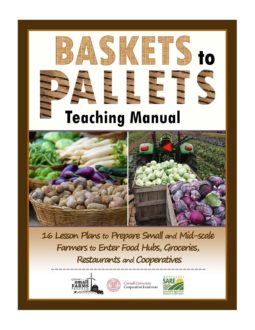The Baskets to Pallets Teaching Manual was written by Violet Stone, New York state SARE coordinator, as part of a state-based professional development program aimed at addressing the gap of tools to support farmers as they decide if, when and how to sell to a wholesale market.
The Manual contains lessons plans and teaching resources that educators and others who work with farmers can use to to meet the needs of farmers in New York and the Northeast who have been primarily direct marketing but who are seeking to explore wholesale markets, specifically groceries, food hubs, restaurants or cooperatives.
It incorporates two Case Study Farms, based on an actual produce and livestock farm currently operating in New York.
Additional materials are available at: https://smallfarms.cornell.edu/projects/baskets-to-pallets/b2p/.
Table of Contents
- Training Introduction
- Preface: Consumer Trends & the Demand for Local
- Module 1: Soft Skills
- 1.1 Mission and Vision: The Compass Charting Future Success
- Module 2: Marketing
- 2.1 Choosing & Evaluating Marketing Channels
- 2.2 Building Relationships with Buyers
- 2.3 Communication in the Wholesale Channel
- 2.4 Collaborative Marketing
- Module 3: Business Management
- 3.1 Assessing Business Strengths and Weaknesses
- 3.2 Assessing & Managing Human Capital
- 3.3 Record Keeping for Wholesale Enterprises
- 3.4 Decision Making
- Module 4: Production
- 4.1 Uniformity, Consistency and Scheduling
- a. Produce
- b. Livestock
- 4.2. Labeling, Grading and Packaging
- 4.3 Record Keeping
- Module 5: Food Safety
- 5.1 Introduction to Produce Safety
- 5.2 Food Safety Risks on the Farm
- 5.3 Meeting Your Market’s Produce Safety Requirements
Want more information? See the related SARE grant:
- Baskets to Pallets: Preparing Small and Mid-scale Farmers to Enter Food Hubs, Groceries, Restaurants and Cooperatives (NENY14-001)
This material is based upon work that is supported by the National Institute of Food and Agriculture, U.S. Department of Agriculture through the Sustainable Agriculture Research and Education (SARE) program. Any opinions, findings, conclusions, or recommendations expressed in this publication are those of the author(s) and should not be construed to represent any official USDA or U.S. Government determination or policy.
